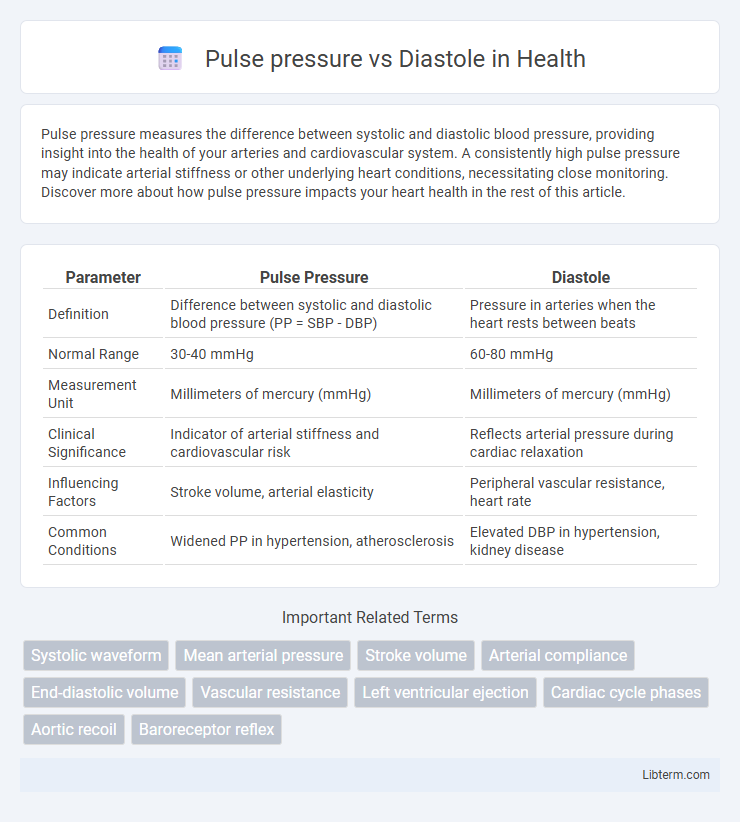Pulse pressure measures the difference between systolic and diastolic blood pressure, providing insight into the health of your arteries and cardiovascular system. A consistently high pulse pressure may indicate arterial stiffness or other underlying heart conditions, necessitating close monitoring. Discover more about how pulse pressure impacts your heart health in the rest of this article.
Table of Comparison
| Parameter | Pulse Pressure | Diastole |
|---|---|---|
| Definition | Difference between systolic and diastolic blood pressure (PP = SBP - DBP) | Pressure in arteries when the heart rests between beats |
| Normal Range | 30-40 mmHg | 60-80 mmHg |
| Measurement Unit | Millimeters of mercury (mmHg) | Millimeters of mercury (mmHg) |
| Clinical Significance | Indicator of arterial stiffness and cardiovascular risk | Reflects arterial pressure during cardiac relaxation |
| Influencing Factors | Stroke volume, arterial elasticity | Peripheral vascular resistance, heart rate |
| Common Conditions | Widened PP in hypertension, atherosclerosis | Elevated DBP in hypertension, kidney disease |
Understanding Pulse Pressure and Diastole: Key Concepts
Pulse pressure represents the numerical difference between systolic and diastolic blood pressure, reflecting the force exerted by the heart with each beat, while diastole is the phase when the heart relaxes and fills with blood, allowing the arteries to maintain steady pressure. Understanding the relationship between pulse pressure and diastolic pressure is crucial for assessing arterial health and cardiovascular risk, as elevated pulse pressure often indicates stiff arteries and increased workload on the heart. Monitoring both pulse pressure and diastolic pressure provides insight into vascular compliance and overall cardiac function, aiding in the early detection of hypertension and other cardiovascular conditions.
The Physiology Behind Pulse Pressure
Pulse pressure, calculated as the difference between systolic and diastolic blood pressure, reflects the force generated by each heartbeat and the compliance of arterial walls. Diastolic pressure represents the minimum arterial pressure during ventricular relaxation, influencing the baseline tension in arteries, which affects pulse pressure amplitude. The interaction between arterial stiffness and diastolic runoff determines pulse pressure, making pulse pressure a key indicator of vascular health and cardiac workload.
What Is Diastole? A Detailed Overview
Diastole is the phase of the cardiac cycle when the heart muscles relax and the chambers fill with blood, enabling efficient oxygen delivery throughout the body. Pulse pressure, defined as the difference between systolic and diastolic blood pressures, reflects the force the heart generates with each contraction and is influenced by arterial elasticity during diastole. Understanding diastole is crucial for interpreting pulse pressure, as abnormalities in diastolic pressure can indicate cardiovascular risks such as hypertension or arterial stiffness.
Pulse Pressure vs Diastolic Pressure: Core Differences
Pulse pressure is the numerical difference between systolic and diastolic blood pressure, reflecting the force the heart generates each time it contracts, whereas diastolic pressure measures the arterial pressure during the heart's relaxation phase. While pulse pressure provides insights into arterial stiffness and cardiovascular risk, diastolic pressure indicates the baseline pressure required to maintain blood flow during cardiac rest. Understanding these core differences aids in diagnosing various cardiovascular conditions and tailoring treatment strategies effectively.
Clinical Significance of Pulse Pressure
Pulse pressure, defined as the difference between systolic and diastolic blood pressure, is a crucial indicator of arterial stiffness and cardiovascular health. Elevated pulse pressure, typically above 60 mmHg, is associated with increased risk of myocardial infarction, stroke, and heart failure, especially in elderly patients. Monitoring pulse pressure alongside diastolic values aids clinicians in assessing vascular aging and tailoring treatment for hypertension and atherosclerosis.
Importance of Diastolic Pressure in Cardiovascular Health
Diastolic pressure measures the force exerted on artery walls when the heart rests between beats, playing a crucial role in maintaining adequate coronary artery perfusion. A consistently low diastolic pressure can reduce blood flow to the heart muscle, increasing the risk of ischemic heart disease and compromised cardiac function. Monitoring diastolic pressure alongside pulse pressure provides valuable insights into arterial stiffness and cardiovascular risk stratification.
Factors Affecting Pulse Pressure and Diastole
Pulse pressure, the difference between systolic and diastolic blood pressure, is influenced by factors such as arterial stiffness, stroke volume, and heart rate, while diastole duration is affected by heart rate and vascular resistance. Increased arterial stiffness elevates pulse pressure by raising systolic pressure and reducing diastolic pressure, whereas prolonged diastole improves coronary perfusion and reduces cardiac workload. Both pulse pressure and diastolic phase are critical in assessing cardiovascular health, with hypertension and atherosclerosis significantly impacting their relationship.
Diagnostic Value: Pulse Pressure and Diastole in Practice
Pulse pressure, calculated as the difference between systolic and diastolic blood pressure, provides critical insight into arterial stiffness and cardiovascular risk beyond diastolic measurements alone. Elevated pulse pressure often indicates reduced arterial compliance, which correlates strongly with increased risk of heart failure and ischemic events, while diastolic pressure reflects peripheral vascular resistance and coronary perfusion status. Combining pulse pressure and diastolic pressure readings enhances diagnostic accuracy in hypertension management and cardiovascular risk stratification in clinical practice.
Abnormal Pulse Pressure vs Diastolic Dysfunction
Abnormal pulse pressure, often characterized by a widened gap between systolic and diastolic blood pressure, is strongly associated with diastolic dysfunction, where the heart's ability to relax and fill is impaired. Elevated pulse pressure indicates increased arterial stiffness, which exacerbates left ventricular filling pressures commonly seen in diastolic heart failure. Monitoring pulse pressure alongside diastolic measurements provides critical insights into cardiovascular risk stratification and guides management of patients with diastolic dysfunction.
Improving Cardiovascular Outcomes: Managing Pulse Pressure and Diastolic Levels
Managing pulse pressure and diastolic blood pressure is crucial for improving cardiovascular outcomes, as high pulse pressure often indicates arterial stiffness and increased cardiovascular risk. Maintaining diastolic levels within a healthy range helps ensure adequate coronary perfusion during heart relaxation, reducing the risk of ischemic events. Targeted interventions such as lifestyle modification and antihypertensive therapy can optimize both pulse pressure and diastolic blood pressure, mitigating cardiovascular complications.
Pulse pressure Infographic

 libterm.com
libterm.com